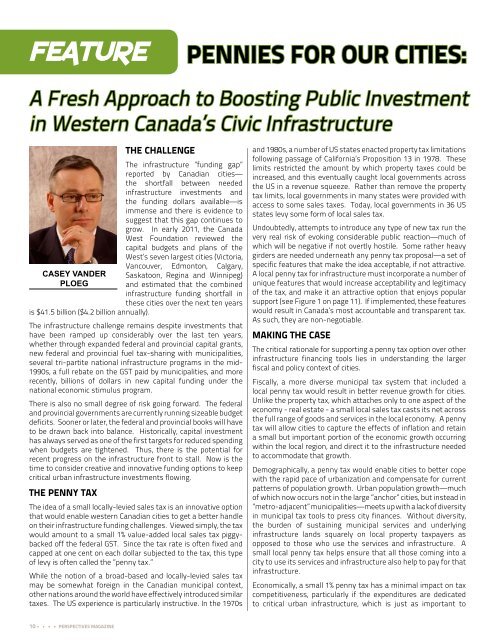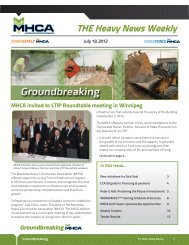2012 Perspectives Magazine - Manitoba Heavy Construction ...
2012 Perspectives Magazine - Manitoba Heavy Construction ...
2012 Perspectives Magazine - Manitoba Heavy Construction ...
You also want an ePaper? Increase the reach of your titles
YUMPU automatically turns print PDFs into web optimized ePapers that Google loves.
FEATURE<br />
PENNIES FOR OUR CITIES:<br />
A Fresh Approach to Boosting Public Investment<br />
in Western Canada’s Civic Infrastructure<br />
casey vander<br />
ploeg<br />
is $41.5 billion ($4.2 billion annually).<br />
THE CHALLENGE<br />
The infrastructure ”funding gap”<br />
reported by Canadian cities—<br />
the shortfall between needed<br />
infrastructure investments and<br />
the funding dollars available—is<br />
immense and there is evidence to<br />
suggest that this gap continues to<br />
grow. In early 2011, the Canada<br />
West Foundation reviewed the<br />
capital budgets and plans of the<br />
West’s seven largest cities (Victoria,<br />
Vancouver, Edmonton, Calgary,<br />
Saskatoon, Regina and Winnipeg)<br />
and estimated that the combined<br />
infrastructure funding shortfall in<br />
these cities over the next ten years<br />
The infrastructure challenge remains despite investments that<br />
have been ramped up considerably over the last ten years,<br />
whether through expanded federal and provincial capital grants,<br />
new federal and provincial fuel tax-sharing with municipalities,<br />
several tri-partite national infrastructure programs in the mid-<br />
1990s, a full rebate on the GST paid by municipalities, and more<br />
recently, billions of dollars in new capital funding under the<br />
national economic stimulus program.<br />
There is also no small degree of risk going forward. The federal<br />
and provincial governments are currently running sizeable budget<br />
deficits. Sooner or later, the federal and provincial books will have<br />
to be drawn back into balance. Historically, capital investment<br />
has always served as one of the first targets for reduced spending<br />
when budgets are tightened. Thus, there is the potential for<br />
recent progress on the infrastructure front to stall. Now is the<br />
time to consider creative and innovative funding options to keep<br />
critical urban infrastructure investments flowing.<br />
THE PENNY TAX<br />
The idea of a small locally-levied sales tax is an innovative option<br />
that would enable western Canadian cities to get a better handle<br />
on their infrastructure funding challenges. Viewed simply, the tax<br />
would amount to a small 1% value-added local sales tax piggybacked<br />
off the federal GST. Since the tax rate is often fixed and<br />
capped at one cent on each dollar subjected to the tax, this type<br />
of levy is often called the ”penny tax.”<br />
While the notion of a broad-based and locally-levied sales tax<br />
may be somewhat foreign in the Canadian municipal context,<br />
other nations around the world have effectively introduced similar<br />
taxes. The US experience is particularly instructive. In the 1970s<br />
and 1980s, a number of US states enacted property tax limitations<br />
following passage of California’s Proposition 13 in 1978. These<br />
limits restricted the amount by which property taxes could be<br />
increased, and this eventually caught local governments across<br />
the US in a revenue squeeze. Rather than remove the property<br />
tax limits, local governments in many states were provided with<br />
access to some sales taxes. Today, local governments in 36 US<br />
states levy some form of local sales tax.<br />
Undoubtedly, attempts to introduce any type of new tax run the<br />
very real risk of evoking considerable public reaction—much of<br />
which will be negative if not overtly hostile. Some rather heavy<br />
girders are needed underneath any penny tax proposal—a set of<br />
specific features that make the idea acceptable, if not attractive.<br />
A local penny tax for infrastructure must incorporate a number of<br />
unique features that would increase acceptability and legitimacy<br />
of the tax, and make it an attractive option that enjoys popular<br />
support (see Figure 1 on page 11). If implemented, these features<br />
would result in Canada’s most accountable and transparent tax.<br />
As such, they are non-negotiable.<br />
MAKING THE CASE<br />
The critical rationale for supporting a penny tax option over other<br />
infrastructure financing tools lies in understanding the larger<br />
fiscal and policy context of cities.<br />
Fiscally, a more diverse municipal tax system that included a<br />
local penny tax would result in better revenue growth for cities.<br />
Unlike the property tax, which attaches only to one aspect of the<br />
economy - real estate - a small local sales tax casts its net across<br />
the full range of goods and services in the local economy. A penny<br />
tax will allow cities to capture the effects of inflation and retain<br />
a small but important portion of the economic growth occurring<br />
within the local region, and direct it to the infrastructure needed<br />
to accommodate that growth.<br />
Demographically, a penny tax would enable cities to better cope<br />
with the rapid pace of urbanization and compensate for current<br />
patterns of population growth. Urban population growth—much<br />
of which now occurs not in the large ”anchor” cities, but instead in<br />
”metro-adjacent” municipalities—meets up with a lack of diversity<br />
in municipal tax tools to press city finances. Without diversity,<br />
the burden of sustaining municipal services and underlying<br />
infrastructure lands squarely on local property taxpayers as<br />
opposed to those who use the services and infrastructure. A<br />
small local penny tax helps ensure that all those coming into a<br />
city to use its services and infrastructure also help to pay for that<br />
infrastructure.<br />
Economically, a small 1% penny tax has a minimal impact on tax<br />
competitiveness, particularly if the expenditures are dedicated<br />
to critical urban infrastructure, which is just as important to<br />
10 perspectives <strong>Magazine</strong>

















